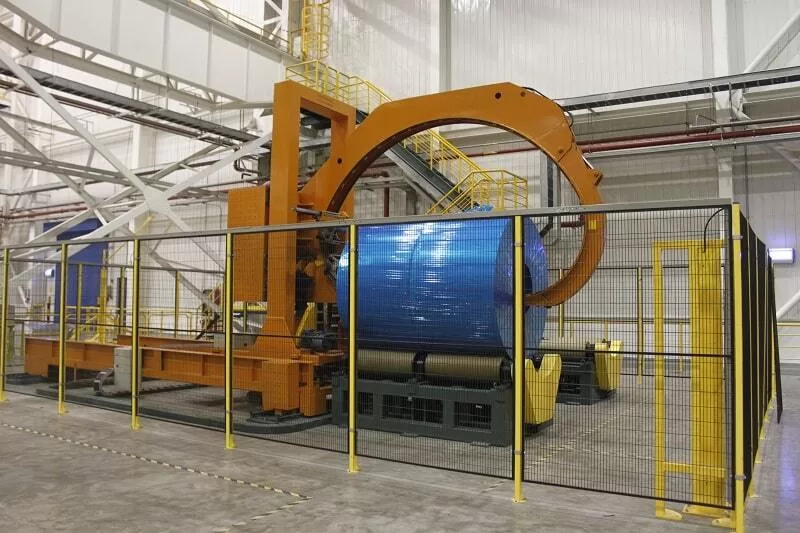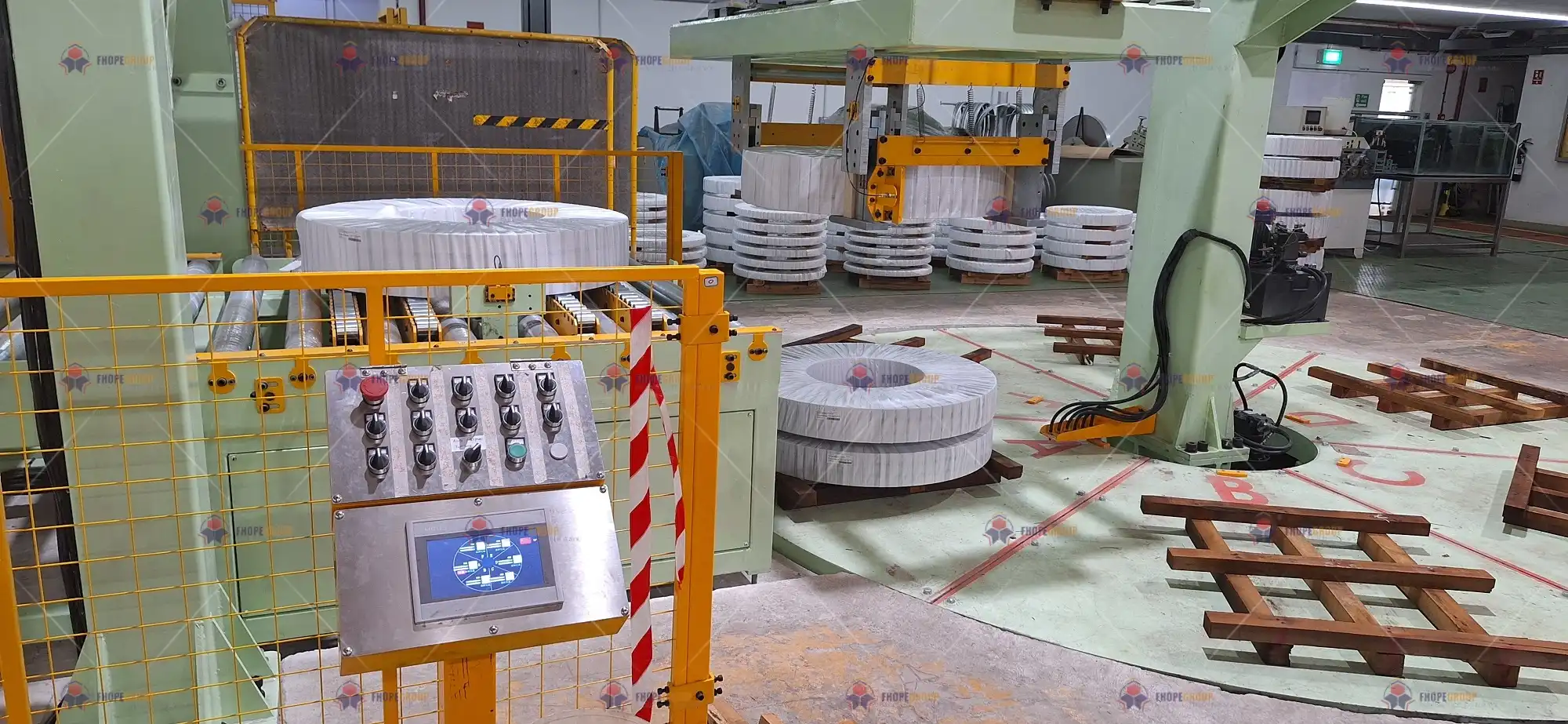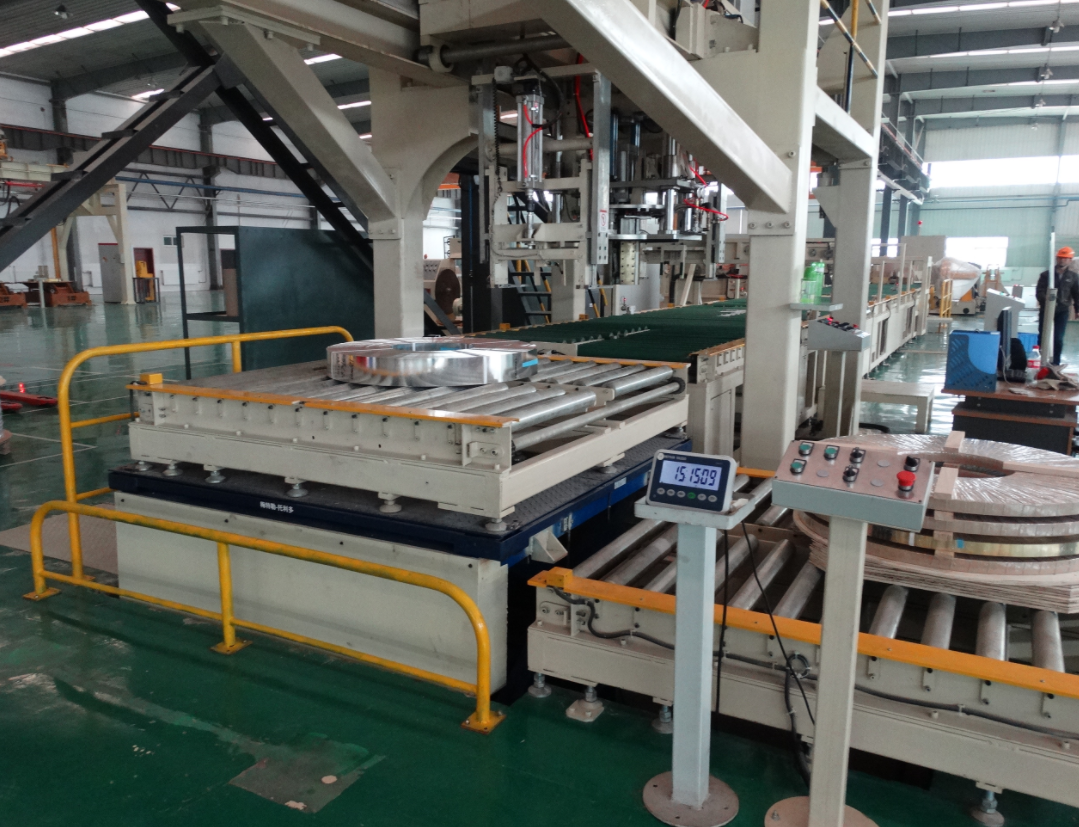Are your steel mill's profits being eaten away by aging packing equipment? I see it all the time. Constant breakdowns, high labor costs, and inconsistent package quality are common headaches for owners and managers. These issues don't just affect the bottom line; they create a ripple effect. Production targets are missed, customer complaints rise, and your team is constantly fighting fires instead of focusing on growth. It feels like you're running just to stand still. The solution, which I've dedicated my career to, lies in strategic automation. A modern, integrated coil packing line can transform your end-of-line operations from a cost center into a competitive advantage.
Coil packing automation delivers results by integrating strapping, wrapping, and handling into a single, seamless process. This proven approach reduces manual labor by up to 70%, minimizes product damage during transit, and increases throughput significantly. It directly boosts your operational efficiency and profitability by making the final stage of your production as reliable and data-rich as the first. This is how you gain control over your costs and quality.

You might be thinking, "Another big investment? My current line works... most of the time." I understand that caution. I started as an engineer on the factory floor, so I've seen firsthand the pressure to make do with what you have. But through my journey of building my own packing machine factory, I learned a crucial lesson. The right automation isn't just an expense. It's a strategic move to solve your biggest challenges, from maintenance costs to digital integration. Let's break down how.
How Can an Automated Packing Line Tackle Rising Maintenance Costs and Downtime?
Does your maintenance team spend more time patching up old machinery than performing preventative checks? An aging packing line, one that has been running for over 15 years, is a ticking time bomb of failures and unplanned downtime. I've walked through countless mills and seen the same story. Each breakdown halts your entire production flow. This means lost output, delayed shipments, and overtime pay for repairs. The costs add up quickly, far beyond just the price of a spare part. A new automated packing line is designed for reliability. With modern components, predictive maintenance alerts, and robust construction, it shifts your focus from reactive repairs to proactive management, helping you achieve that critical 95% uptime goal.
An automated packing line tackles costs and downtime by replacing worn-out, failure-prone components with new, reliable technology. It incorporates features like IoT sensors for predictive maintenance and standardized parts for quicker repairs. This approach drastically reduces unplanned stops and the associated maintenance budget, turning a liability into a dependable asset.

The True Cost of "Good Enough" Equipment
When I was starting out, a mentor told me something that stuck with me: "The most expensive machine you can own is the one that doesn't run." This is especially true for equipment that seems "good enough." An old packing line might still wrap coils, but at what hidden cost? The constant need for manual adjustments, the slow cycle times, and the ever-present risk of a catastrophic failure create a drain on resources that often goes unmeasured. I remember visiting a mill in the Midwest. Their old wrapper was down for three full days waiting for a proprietary gear that had to be shipped from Europe. The cost of lost production dwarfed the cost of the part by a hundred times. This is the reality of relying on aging technology.
Modern automation is about more than just speed; it's about predictability. You, as a leader, need to be able to forecast your output and costs accurately. You can't do that if your packing line is a constant variable. A new line is an engineered system designed for endurance. The real value isn't just in the new steel and motors; it's in the peace of mind that comes from knowing it will work, shift after shift. Here is a simple breakdown of the differences I’ve seen.
| Feature | Old Line (>15 years) | Modern Automated Line |
|---|---|---|
| Maintenance | Reactive, Frequent | Predictive, Scheduled |
| Downtime | Unplanned, High | Minimal, Planned |
| Spare Parts | Obsolete, Hard to Find | Standardized, Available |
| Labor | High, Manual Intervention | Low, Supervisory |
| Data | None | Real-time Performance Data |
By investing in a modern line, you are fundamentally changing your maintenance strategy. You move from a costly, stressful, reactive model to a planned, controlled, and proactive one. This is a critical step in stabilizing production and protecting your profit margins.
Can Modern Coil Packing Systems Really Lower Your Energy Consumption?
Are fluctuating electricity and fuel prices making it impossible to predict your production costs? It’s a major challenge across the industry. Your old equipment, with its inefficient motors and power-hungry hydraulic systems, is likely a major energy drain. This energy waste is a silent profit killer. Every kilowatt-hour wasted is money you can't invest in growth, innovation, or your people. It also makes it harder to meet increasingly strict environmental regulations, which are becoming a major factor in our industry. Modern packing systems, however, are engineered with energy efficiency as a core principle. They use advanced technology to do the same work with significantly less power, helping you hit that target of a 10% reduction in unit product energy consumption.
Yes, modern coil packing systems can and do lower your energy consumption. They achieve this by using high-efficiency servo motors instead of outdated hydraulics, implementing intelligent sleep modes during idle periods, and optimizing all mechanical movements to eliminate wasted energy. These features combined can reduce the packing line's specific energy use by 20-30% or more.

Pinpointing the Energy Hogs in Your Packing Line
I know from your background that you appreciate the power of innovation, like your investment in a high-furnace heat recovery system. You've already seen the massive benefits of smart energy management on a large scale. The exact same principle applies to your packing line, just on a different piece of equipment. The first step is to identify where the energy is actually going. In my experience with older lines, the culprit is almost always the hydraulic power unit. These units often run continuously, even when the machine is idle, constantly burning power to maintain pressure. It's like leaving a car engine running all day just in case you need to drive for a few minutes.
Modern design philosophy has completely changed this. When I started designing my own machines, I made a conscious decision to move away from hydraulics wherever possible. We shifted to all-electric systems using servo motors and variable frequency drives (VFDs). The difference is night and day. A servo motor uses significant power only for the split second it's performing a task. A VFD ensures a conveyor motor only spins as fast as it needs to, ramping down when not in use. This granular control over power consumption adds up to huge savings. A client in Mexico was shocked when they saw their power bill after installing one of our new lines. The packing line's consumption dropped by nearly 40%. They initially bought it for speed, but the energy savings delivered a faster ROI than they ever calculated.
| Component | Old System | Modern System | Energy Impact |
|---|---|---|---|
| Main Drive | Large Hydraulic Power Pack | Electric Servo Motors | Up to 50% Less Energy Use |
| Conveyors | Always-on AC Motors | Motors with VFDs/Sleep Mode | Up to 30% Less Idle Energy Use |
| Wrapping Ring | Chain/Mechanically Driven | Direct Drive with VFD | 15% Less Energy, Better Control |
This isn't just about being "green." This is about pure economics. Reducing your energy cost per ton of steel produced is a direct boost to your bottom line, and a modern packing line is a key tool to achieve that.
What Role Does a Smart Packing Line Play in Your Mill's Digital Transformation?
I see you have a vision for a fully connected, data-driven steel mill. This is the future of our industry. But does your end-of-line packaging still operate like an isolated island, with manual data entry and no real-time visibility? This data gap means your MES and ERP systems are working with incomplete information. You can't truly optimize production flow, track a coil from the furnace to the final shipment, or make data-backed decisions if the final, crucial step of your process is a black box. A smart packing line is not just a machine; it's a data node. It is designed from the ground up to seamlessly integrate with your existing digital platforms, feeding them the critical information needed to achieve total production visualization.
A smart packing line acts as the final and most critical data collection point in your production process. By integrating directly with your MES and ERP systems, it automatically records the coil ID, weight, dimensions, packaging materials used, and final package status. This provides 100% accurate, real-time data for full traceability, inventory management, and operational intelligence.

From Dumb Iron to a Smart Asset
Many people think digital transformation is just about buying big, expensive software platforms. But in my 25 years in this business, I've learned that the platforms are useless without good, clean data. The most successful projects I've seen are the ones that start by upgrading the equipment on the factory floor to ensure it can "speak" the language of data. Your packing line is a critical source of that language. An old, offline machine provides you with nothing. A modern, connected machine becomes a valuable asset in your digital strategy.
So how does this work in practice? It starts with the machine's brain, the PLC (Programmable Logic Controller). We build our machines on open architecture platforms, like Siemens or Allen-Bradley, that communicate using standard industry protocols like OPC-UA or Ethernet/IP. This means the machine can talk directly to your plant's MES. When a coil arrives at the packing line, a scanner reads its ID. The packing line then queries the MES for the correct packaging "recipe." After it's wrapped and strapped, the machine sends a confirmation back to the MES and ERP, updating the coil's status to "finished goods" and adding it to the inventory, complete with accurate weight and dimensions. It's a fully automated data handshake.
| Data Point | Source | System Integration | Business Value |
|---|---|---|---|
| Coil ID | Barcode/RFID Scanner | MES/ERP | Full "Furnace to Truck" Traceability |
| Weight/Dimensions | Integrated Scales/Sensors | MES/ERP/WMS | Accurate Shipping Docs & Inventory |
| Packaging Status | Machine PLC | MES/Production Dashboard | Real-time Production Visibility |
| Fault Codes & Alarms | Machine PLC | Maintenance System (CMMS) | Predictive Alerts & Faster Repairs |
This integration eliminates human error from data entry, provides real-time visibility for your sales and logistics teams, and gives your maintenance team the data they need for predictive analytics. It transforms your packing line from a piece of "dumb iron" into an intelligent node in your digital ecosystem.
Why Should You Look for a Partner, Not Just a Supplier, for Your Next Equipment Upgrade?
Have you ever purchased a machine only to have the supplier disappear after the check clears? You are left with a manual you can barely understand and no one to call when things go wrong. I have heard this story too many times. This transactional approach creates huge risks for your business. The installation gets delayed, your team isn't properly trained, and you struggle to get support for maintenance or future upgrades. That "cheaper" machine ends up costing you far more in frustration, downtime, and lost opportunities. A true strategic partner, on the other hand, invests in your success. They work with you from the initial design concept through installation, training, and long-term support, ensuring you get the maximum value from your investment for years to come.
You should seek a partner because a complex automation project requires more than just a machine. It requires expertise in process integration, plant layout design, project management, installation, operator training, and ongoing support. A partner collaborates with you to solve your specific business challenges—like reducing operational costs or improving safety—not just sell you a piece of standard equipment.

The Partnership Lifecycle: Beyond the Purchase Order
When I started my own factory, I had to be the engineer, the salesperson, and the support technician all at once. I learned very quickly that my customers' success was my success. If their machine ran well, they would grow and buy more. If it didn't, my reputation was on the line. This is why I built SHJLPACK on a foundation of partnership. It's not just a sales tactic for me; it's my core belief, born from my own journey. I achieved my own success because this industry was good to me, and now my mission is to share that knowledge and help others succeed.
A true partnership goes far beyond a single transaction. It’s a lifecycle.
- Consultation & Design: It starts with listening. We need to understand your specific coil sizes, your plant layout, your production flow, and your business goals. There is no "one-size-fits-all" solution in this business.
- Manufacturing & Testing: We build the machine to the agreed-upon specifications. We encourage our partners to visit for a factory acceptance test (FAT) before it ever ships, so they can see it run and request adjustments.
- Installation & Commissioning: This is a critical phase. We send experienced engineers to your site. I've sent my best people to mills from Mexico to the United States to ensure everything is installed correctly and integrated seamlessly with the existing line.
- Training: A new machine is only as good as the team operating it. We provide comprehensive, hands-on training to empower your operators and maintenance staff to run and care for the line confidently.
- Long-Term Support: Our relationship doesn't end when the final payment is made. We are there for you with spare parts, remote diagnostics, and expert advice as you grow and as regulations change.
A supplier sells you a machine. A partner helps you achieve your goal of reducing overall operating costs by 8% or more. That's the difference, and it’s everything.
Conclusion
Automating your coil packing is more than an upgrade. It's a strategic investment in reliability, efficiency, and future growth. The right partner makes all the difference in achieving your goals.




